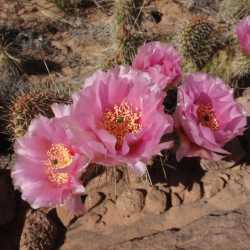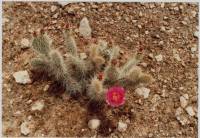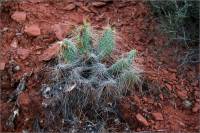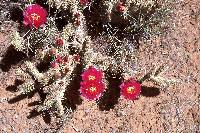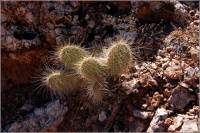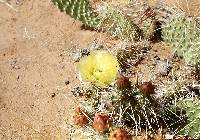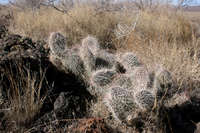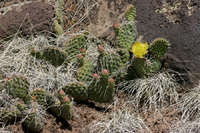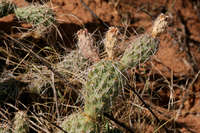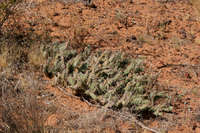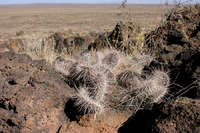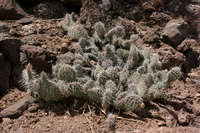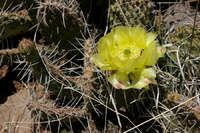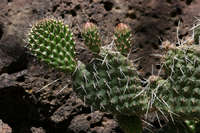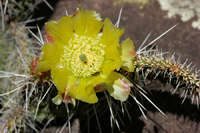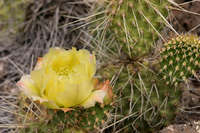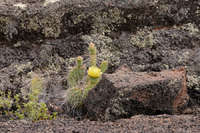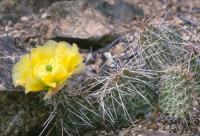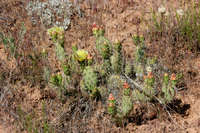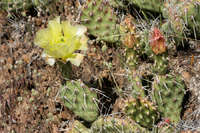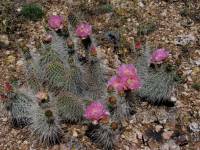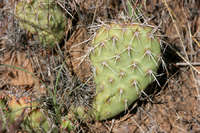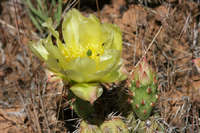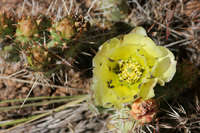Shrubs, low, 10-25 cm, with ± prostrate branches. Stem segments not easily detached, green, elliptic to narrowly to broadly obovate to circular, 4-27 × 2-18 cm, low tuberculate; areoles 4-14 per diagonal row across midstem segment, subcircular, 3-6 mm; wool tan to brown. Spines at all or only distal areoles of stem segment, terete to flattened, stout to acicular to bristlelike, straight to curling, of 1 or 2 kinds; if 1 kind: 0-18 per areole, spreading and curling in various directions, sometimes straight, erect, ascending to deflexed, yellow to dark brown to black, turning gray, pink-gray to gray-brown, longest (35-)40-90(-185) mm; if ± 2 kinds: major spines (0-)1-5, reflexed to porrect, yellow-brown to brown to gray, longest 20-150 mm; minor spines (0-)5-11, deflexed, white to white-gray, longest 4-16 mm. Glochids inconspicuous, in narrow, tidy crescent at adaxial edge of areole or in broad, brushy crescent and tuft, yellow to reddish, aging brown, to 10 mm. Flowers: inner tepals yellow to magenta throughout, 25-40 mm; filaments white, yellow, or red to magenta (flowers may superficially appear bicolored); anthers yellow; style white to pale pink; stigma lobes green. Fruits tan to brown, ± cylindric, 15-45 × 12-25 mm, dry at maturity, glabrous, sometimes burlike; areoles 10-33, each or only distal areoles bearing 3-16 spines, 4-20 mm. Seeds tan to gray, flattened, warped, oblong to subcircular, 3-7 × 2-4 mm; girdle protruding 1-2 mm.
Populations of Opuntia polyacantha with spines few or absent (especially var. hystricina) were the basis for several names including O. juniperina, O. utahensis, and O. rhodantha.
Plant: Shrubs low, with ± prostrate branches, 5-50 cm tall. PADS green, glabrous, the terminal ones not easily detached, elliptic, narrowly to broadly obovate to circular, (4-)6-27 cm long, 2-18 cm broad. AREOLES 4-14 in a row diagonal across midpad, subcircular, 3-6 mm in diameter; wool tan to brown
Leaves: SPINES at all to only distal areoles of pad, either of one kind: 1) not separable into major and minor spines, yellow to dark-brown to black turning gray, pink-gray to gray-brown, (0-)1-18 per areole, the largest (3.5-)4-9(-18.5) cm long and spreading and curling in all directions to ± straight, erect, ascending to deflexed or 2) of ± two kinds: major spines yellow-brown to brown to gray, reflexed to porrect, 1-5, the largest 2-15 cm long; minor spines white to white-gray, deflexed, 5-11, the largest 0.4-1.6 cm long. GLOCHIDS yellow, aging brown, in crescent at areole apex, 1-5 mm long
Flowers: inner tepals yellow to magenta, 2.5-4 cm long; filaments white, yellow to magenta; style white to pale pink; fresh stigmas green
Fruit: FRUITS tan to brown, dry at maturity, 1.5-4.5 cm long, 1.2-2.5 cm in diameter; areoles 10-33, each or only the uppermost bearing 3-16 spines, 4-20 mm long, sometimes bur-like. SEEDS tan to gray, oblong to subcircular, 3-7 mm long, 2-4 mm wide; girdle protruding 1-2 mm.
REFERENCES: Pinkava, Donald J. Cactaceae. 2003. J. Ariz. - Nev. Acad. Sci. Volume 35(2).
Common Name: plains pricklypear
Duration: Perennial
Protected Status: No status in Arizona.
Spines: Spines emerge from round, tan to brown areoles; spines usually present at all areoles, but sometimes only the areoles near tops of pads; spines can be quite variable, with either 1 or 2 types of spines at each areole. If there is one type of spine, there are up to 18 per areole, spreading or curling in all directions, yellow, brown, or black, with the largest 4-9 cm long. If there are two types of spines, there are 1-5 of the larger type of spines at each areole, which are reflexed to spreading, yellow, brown, or gray, and 2-15 cm long; there are also 5-11 of the smaller type of spine at each areole,which are deflexed, white or light gray, and only about 1 cm long. Glochids form a slender crescent or larger patch at each areole, yellow to reddish and turning brown with age, 1 cm long.
Flowers: Petals numerous, yellow to magenta, obovate, 2.5 to 4 cm long; stamens numerous, with filaments that are white, yellow, red, or magenta, topped with yellow anthers; style white or pale pink, topped with a ring of green stigma lobes.
Fruits: Fruits dry and sometimes burr-like (not fleshy or juicy), tan to brown, cylindric, 1.5-4.5 cm long by 1-2 cm wide, with 10-30 areoles, each areole bearing 3-16 short spines, up to 2 cm long; seeds flat and round to oblong, tan to gray, 3-7 mm wide.
Ecology: Found in a variety of habiats, generally from 2,000 to 8,000 ft; flowers May-July.
Distribution: Much of western N. Amer., from Alberta and Saskatchewan south through ID, MT, and ND to e CA, NV, AZ, NM, OK, and w TX
Notes: This is a low, sprawling cactus of the middle elevations and cold deserts in the Southwest. It is distinguished by its relatively small pads and its abundant spines, which are usually light-colored, long, overlapping, and pointing in all directions, especially downward, so that one cannot reach their finger between the spines and touch the pad of the cactus. The fruits are dry spiny capsules, not fleshy and juicy like many other prickly pears. The flowers can be yellow or magenta, with both colors sometimes found on the same plant. There are 5 currently recognized varieties, 3 of which are found in New Mexico and 4 of which are found in Arizona. See Flora of North America (2004), Vascular Plants of Arizona Project (Pinkava 2003), or the Flora Neomexicana (Allred and Ivey, 2012) for more details on varieties.
Ethnobotany: This species had many uses, including as a poison for hunting, as food, medicine, glue, and dye. The spines were used as fish hooks and the seeds were made into beads.
Etymology: Opuntia is from the Latin root puncti for prickled; polyacantha means with many thorns.
Synonyms: Many, see Tropicos
Editor: Lcrumbacher 2010, AHazelton 2017
A similar western sp. with 6-10 spines per areole and dry frs, has been reported e. to Wis. and Mo.
Gleason, Henry A. & Cronquist, Arthur J. 1991. Manual of vascular plants of northeastern United States and adjacent Canada. lxxv + 910 pp.
©The New York Botanical Garden. All rights reserved. Used by permission.



